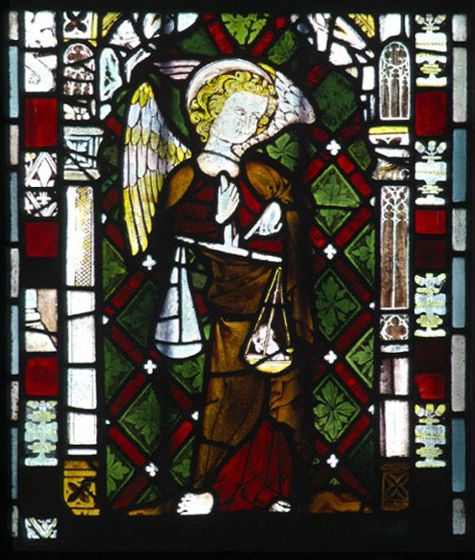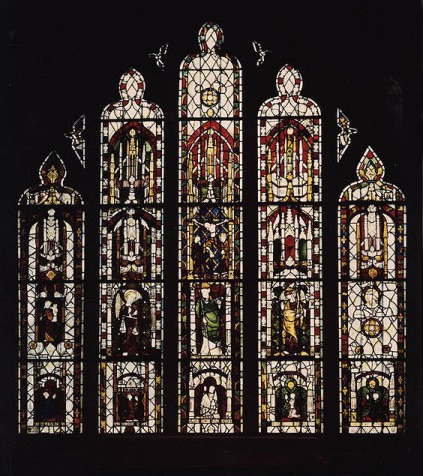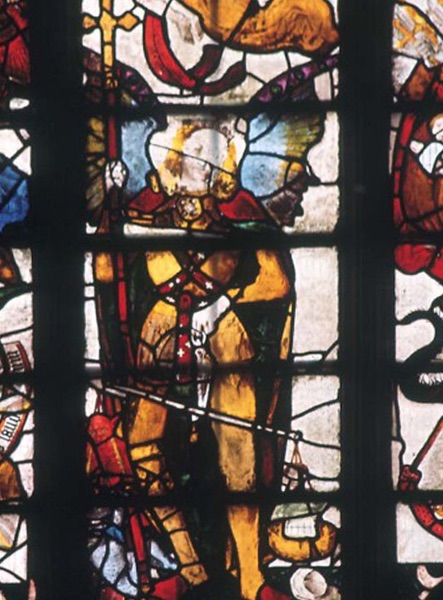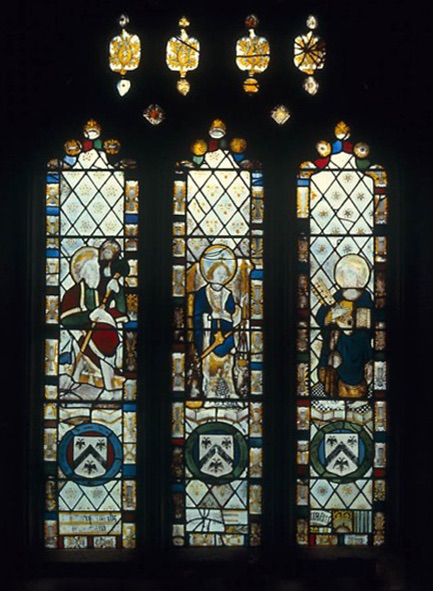medieval stained glass windows
Although no Church was recorded at Eaton Bishop in the Domesday survey (begun within twenty years of the Norman Conquest), it has been suggested that some of the material in the east wall of the tower may pre-date 1066 and that rather more of it dates to the following few decades; this suggests at the very least a foundation on the site since the late eleventh century. The building, which has undergone a series of rebuilding campaigns, would most likely at this time have been smaller and certainly lower than it is today

The nave, aisles and chancel arch have been dated to c.1200, while the chancel itself and the window above the chancel arch were constructed about a century later. The modifications brought about in this early fourteenth-century campaign reflect the contemporary desire to illuminate church interiors more effectively, through the incorporation into the new work of large, multi-light windows, and in particular the large, five-light openings in the chancel east wall and the east wall of the nave at clerestory level. With the exception of a modern porch and roofs, the Church's structure is essentially unchanged since workmen left the site in the early decades of the 1300s.
In the mid-nineteenth century, all of the surviving medieval glass was collected together and leaded, primarily, into the east window of the chancel, with smaller amounts and fragments housed in the two adjoining windows to the north and south. In the following century, the glass within the east window was rearranged slightly once again to create the window’s current appearance (fig. 1). The image of St.Michael weighing a soul is almost certainly not a part of the east window’s original glass, which seems to have been of relatively simple composition, comprising a series of kneeling tonsured figures, plus, perhaps, a figure of the Virgin and Child in the central light, set beneath elaborate, elongated canopies and against a grisaille background. It has been suggested by Marshall (see Further Reading below) that the image of St. Michael may come from the large window above the Church's chancel arch.
The Panel: Production and Condition
Despite its original location elsewhere in the Church, the St.Michael panel is directly comparable in its painting style to that of the chancel east window glazing, and was most likely produced by the same workshop at a similar time. The east window glass can, in turn, be dated with some precision through the remains of an inscription that identify the window’s donor as Adam Murimouth. Perhaps best known as chronicler to the reigns of Edward II and III, Murimouth also attained his doctorate in Civil Law (hence the academicals in which one of the kneeling tonsured figures from the window is dressed), and served in a variety of high-profile clerical roles. In the early part of the fourteenth century, he belonged to the canonical communities at the cathedrals of both Hereford and Wells, for example, and in 1328 became Canon, Cantor and Precentor at Exeter.
The inclusion of the word ‘CAN:TOR’ within the Eaton Bishop glass, alongside numerous fragments of Murimouth’s name, confirms that the glass postdates his election to Exeter, and was probably painted c.1330–35. More recently (see Ayers under Further Reading), connections have also been made between Eaton Bishop and the stained glass of the 1320s and 1330s in the Lady Chapel and retrochoir of Wells Cathedral, which share the brilliant colour combinations of ruby, yellow and green glass, although affinities in figure style seem less direct. We can see that although the workshop responsible for panels such as that of St Michael at Eaton Bishop clearly worked frequently in the West Midlands, it was also employed by a number of high-ranking patrons. A wish for association with such figures, rather than simply the proximity of the glaziers, no doubt rendered the workshop attractive to Murimouth, as, perhaps, did the glaziers’ apparent ability to incorporate recent technical innovations into their work.
The golden yellow colour of St Michael’s hair and the tips of his wings represents a relatively early use in England of silver stain, a technique involving the application of a silver-oxide or -nitrate solution to white glass before firing. The technique was used in high-status monuments in France from c.1310 (at Rouen cathedral, and perhaps in Paris), before coming to England in the following decade or so; a panel of glass from Stanford on Avon (Northants.), containing touches of silver stain in its borders, for example, has been dated to c.1315–26. Following its introduction, the silver-stain technique was swiftly adopted throughout England. Whilst in its early years the stain was used essentially as a substitute for yellow pot-metal, it came to be deployed with great sophistication, to intricate and delicate effect, and even, in some works of later centuries, dominated the entire aesthetic of a composition.
Reproduced from 'Vidimus' online magazine



